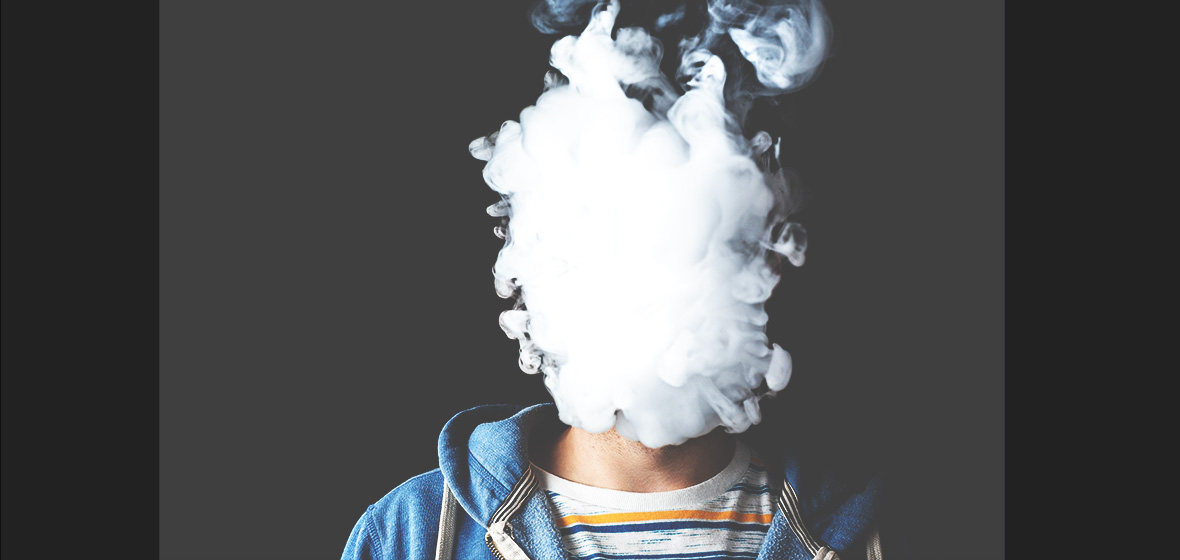In the last few weeks six young people have been rushed to hospital in NSW suffering seizures, vomiting and loss of consciousness – all of them after using vapes purchased via social media app Snapchat.
The vapes contained nicotine, and e-cigarettes of this kind can only be sold legally to someone who has a prescription.
This is not the first time young people in NSW have become extremely ill after using vapes. Last year, for example, a Blue Mountains Grammar senior school student had a prolonged seizure after vaping at school. And around the world many instances of vaping-induced illness are being recorded.
A condition known as EVALI – an acronym for e-cigarette and vaping associated lung injury – was first described in the New England Journal of Medicine in 2019. This is an inflammatory response in the lungs which has been triggered by inhaled substances.
“[EVALI] has now been responsible for dozens of deaths worldwide and many, many more hospitalisations and periods of sickness in teenagers and young adults,” said Dr Anthea Rhodes, a paediatrician at the Royal Children’s Hospital in Melbourne.
A report published in the British Medical Journal showed that children are presenting with growing numbers of asthma and bronchitis-type incidents due to vapes.
Easy to access
Although it’s becoming more and more evident that vaping can harm children’s health, and their increasing regulation around their use, vapes are easy for children to access despite increasing regulation around their use.
Under current legislation in Australia, vapes containing nicotine cannot be purchased without a prescription, and can be sold legally in pharmacies only. Also, it is illegal to sell any vaping product to a minor.
But young people have reported that it’s easy to obtain vaping products, through purchase via social media or over the counter at tobacconists and convenience stores. A study published in the Australian and New Zealand Journal of Public Health found when over a thousand teenagers aged between 15 to 17 were asked if they knew where to find vapes, 80 per cent said they found vapes easy or somewhat easy to buy in retail stores.
Young people have reported that it’s easy to obtain vaping products, through purchase via social media or over the counter.
And illegal vapes are flooding the black market. In March, Sydney-based companies faced penalties for the alleged unlawful importation of more than 100,000 vapes containing nicotine. In June, 170,000 illegal vapes were found near Perth in a truck that started its journey in NSW.
A new generation of dependency
The Generation Vape Research Project, the first research of this kind in Australia, found the majority of NSW teens who vape find it “easy” to access e-cigarettes from multiple illegal sources.
The six-stage research is being led by Cancer Council NSW in partnership with the Daffodil Centre and the University of Sydney, and will extend to July 2026. Its aim is to examine awareness, perceptions, attitudes, knowledge and behaviours relating to the use of e-cigarettes and tobacco among four target groups:
- young adults aged 18-24 years
- young people aged 14-17 years
- parents and/or carers of young people aged 14-17 years
- secondary school teachers.
The results so far show that young people are mainly getting vapes through friends or “dealers” at school or outside of school. Over half of the young people who have vaped reported using a vape they knew contained nicotine. Also, access to vapes through retail sales is increasing.
The research also shows that the rate of vaping is rapidly increasing in Australia, particularly among young people. The latest estimates, according to the federal Health Department, are that one in six teenagers aged 14 to 17 and one in four people young people aged 18 to 24 have vaped.
Federal Health Minister Mark Butler said: “Young people who vape are three times as likely to take up smoking. So is it any wonder that under 25s are the only cohort in the community currently recording an increase in smoking rates?
“Vaping is creating a whole new generation of nicotine dependency in our community.”
‘Vaping is creating a whole new generation of nicotine dependency in our community.’
Butler added, “Vaping was sold to governments and communities around the world as a therapeutic product to help long-term smokers quit. It was not sold as a recreational product – especially not one targeted to our kids, but that is what it has become.”
“An imminent public health disaster”
In May, the Federal Government announced regulations to tighten controls around vaping. The Department of Health stated, in its announcement of proposed measures to reduce the harm of vaping: “Nicotine is highly addictive and poses serious health risks, and medical experts have serious concerns about the health effects of other harmful substances in vaping products.
“The proposed regulations including banning imports of non-prescription vaping products and single-use disposable vapes.
“Under the proposed changes, vapes can only be sold in pharmacies and in ‘pharmaceutical-like’ packaging, with some flavours, colours and other ingredients banned, and the concentration and volume of nicotine reduced.”
The raft of proposed reforms included banning the import of non-prescription vapes and all single-use disposable vapes. It was proposed that all GPs be authorised to provide scripts for patients to obtain vapes, where they need them, and that education and support programs be introduced to encourage people to quit.
The Department of Health and Aged Care released an exposure draft of the legislation that sets out proposals for reforms to tobacco use and vaping: the Public Health (Tobacco and Other Products) Legislation 2023.
In mid-July 2023, the Australian Medical Association (AMA) lodged a submission to this consultation, The AMA expressed its board support for the measures introduced in the bill. AMA President Professor Steve Robson said the reforms are a good start to achieving Australia’s goal of a five per cent or less smoking prevalence in Australia by 2030, set out by the National Tobacco Strategy 2023–2030.
“The new legislation will bring together a range of existing laws and will simplify current tobacco laws by bringing multiple pieces of legislation into a single Bill,” Robson said.
“For too long Australia has had too many loopholes and blind spots in which the predatory tobacco industry has been able to lure our younger generations into taking up recreational vaping.
“The ease of access, the bright colours and fruity flavours, and false assertions the products were free of nicotine have all contributed to an imminent public health disaster. Right under our noses we saw generations quitting cigarettes while young Australians were taking up vapes.”
‘The ease of access, the bright colours and fruity flavours, and false assertions the products were free of nicotine have all contributed to an imminent public health disaster.’
The equivalent of 50 cigarettes
Dr Erin Lalor, CEO of the Alcohol and Drug Foundation, said, “Most people who currently vape in Australia are using non-regulated products, so we have no idea what ingredients are in them, including the nicotine levels.
“Concerningly, a large amount of the non-regulated products sold as non-nicotine vapes do contain nicotine, which means some people who vape, including young people, may be unknowingly consuming nicotine and have formed a dependence.”
NSW Health reports the following findings from research on the potential harm of vapes:
“The main ingredient in vapes is propylene glycol, vegetable glycerine or glycerol. Vapes can contain the same harmful chemicals found in cleaning products, nail polish remover, weed killer and bug spray. They just don’t put it on the pack.
“Vapes come in a number of flavours such as blueberry or bubble-gum that make them appealing. Many vapes also contain nicotine, the same highly addictive substance found in tobacco cigarettes.
“Testing has shown that vapes labelled ‘nicotine-free’ can have high nicotine levels. People can think they are using nicotine-free vapes and can unknowingly quickly develop a nicotine addiction. The nicotine in one vape can be the equivalent of 50 cigarettes. Depending on the size of the vape and nicotine strength, it can be much higher.
“Vapes can cause long-lasting damaging effects on the brain and physical development. This has a particular impact for young people.”
The effects of withdrawal from vaping are also problematic, Lalor said. Withdrawal can leave young people at increased risk of depression and anxiety, and can cause irritability and cravings and concentration and sleep problems.
Helping young people to quit vaping
“Young adulthood is a significant period for the establishment of unhealthy or risky behaviours that persist into adulthood,” Generation Vape researchers say.
Lalor said parents and teachers can play a role in helping young people to address unhealthy behaviours, and it is critical they are supported and encouraged to talk to young people about vaping.
“It’s really important that young people have open and honest conversations about the risks and impacts, from trusted adults in their lives,” she said.
Lalor advised: “The news about the vaping reforms is a good opportunity for parents to bring up the topic with their children. It’s particularly important for young people who vape to be aware of the upcoming changes, potential signs of withdrawal, and what help and support is available for them.”
The Alcohol and Drug Foundation suggests parents help their children quit vaping by encouraging them to identify why they want to stop. Its recommendations read: “having a good reason for quitting can help motivate someone when breaking a habit. Talk to them about why they want to stop, such as the negative health impacts, saving money or not wanting to be/become addicted.”
‘It’s particularly important for young people who vape to be aware of the upcoming changes, potential signs of withdrawal, and what help and support is available for them.’
Parents are also advised to talk to their children about a good time to stop vaping. “The day before a big exam may not be the best time to do so, as their stress level7s are already high. But try not to delay too long, as it can become harder the longer someone is using nicotine.“
Parents should also offer their children techniques for beating cravings such as:
- reminding themselves of the reason why they are quitting
- reminding themselves that the craving will soon pass (usually in a few minutes)
- distracting their brains by engaging in a hobby, getting some exercise or talking to a friend
- chewing gum, or eating a healthy snack
- using a stress ball, toy or pen to distract their hands.
The Foundation also offers advice on empowering children to say no: “Talk about how they can refuse a vape from a friend if offered … If they feel uncomfortable telling a friend their reason for quitting, help them come up with some excuses such as: ‘I don’t like it anymore’, ‘it gives me a headache’ or ‘I don’t want to waste my money’.”
Illegal retailers under fire
NSW Health has a raft of regulations governing for retailers of vaping products and other products containing nicotine. Under these regulations, it is illegal to:
- sell e-cigarettes, e-cigarette accessories, and tobacco products to anyone under 18 years old
- sell e-cigarettes or e-liquids that contain nicotine, including online sales, for retailers other than pharmacies
- display, advertise or promote e-cigarettes
- sell e-cigarettes that make a health claim, such as ‘this product helps smokers to quit.’
E-cigarettes and e-liquids containing nicotine are a prescription-only medicine. This means pharmacists in community pharmacies can supply e-liquids and e-cigarettes (containing nicotine) to their customers (18 years and over) only if they have a valid prescription from a doctor.
The following legislation applicable in NSW makes it illegal to import, buy or attempt to buy or obtain vapes containing nicotine without a doctor’s prescription:
- The Therapeutic Goods Act 1989 (Cth) (on importing e-cigarettes)
- The Customs Act 1901 (Cth) (s. 50 on importing nicotine e-liquid)
- The Poisons and Therapeutic Goods Act 1966 (NSW) (on attempting to obtain, or possess, nicotine vaping liquid)
- The Poisons and Therapeutic Goods Act 1966 (NSW) (s. 9 on the retail sale of nicotine e-cigarettes or e-liquid)
- The Public Health (Tobacco) Act 2008 (NSW) (s. 22 on selling e-cigarettes to minors). Pharmacies need to comply with all retailing requirements set out under this Act.
E-cigarettes that do not contain nicotine are legal in NSW, and adults can buy and use e-cigarettes that do not contain nicotine.
Under the Public Health (Tobacco) Act 2008 (NSW), e-cigarette retailers must register their business details with NSW Health. NSW Health can prosecute retailers for selling products containing liquid nicotine illegally, and for selling e-cigarettes to people under 18 years of age.
NSW Health will send inspectors to visit tobacco and other retailers to check if products containing nicotine are illegally being sold, and take action if businesses are found to be illegally selling products or any tobacco or e-cigarette product to minors.
The location for using vaping products is also regulated. The Smoke-free Environment Act 2000 (NSW) and the Passenger Transport (General) Regulation 2017 (NSW) prohibit the use of e-cigarettes in smoke-free areas.
In the conclusion to its submission the AMA calls for further regulation of vaping products nationally, including greater regulation of advertising and control over online purchases.




